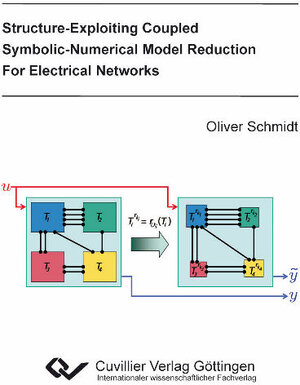
×
![Buchcover ISBN 9783869555027]()
Structure-Exploiting Coupled Symbolic-Numerical Model Reduction For Electrical Networks
von Oliver SchmidtIn order to avoid immense time and fi nancial effort for the production of defi ciently designed
prototypes of integrated circuits (ICs), industrial circuit design uses mathematical models
and simulations to predict and analyse the physical behavior of analog electronical systems.
The thereby generated (partial) differential-algebraic systems of equations are composed of
component characteristics and Kirchhoff laws.
During the last years, increasing miniaturization and integration density of components on a
single chip led to systems containing several millions of equations, which have to be reduced
to their dominant parts in order to handle the complexity. Besides a large number of numerical
analysis and reduction methods, there also exist symbolic techniques, which indeed are costly
to compute, but allow deeper analytical insights into the behavior of the system.
In this book, new strategies for the analysis and reduction of systems of ever-growing size
and complexity are developed by exploiting the hierarchical structure of analog electronical
circuits for coupled symbolic-numerical model reduction. Thereby, the entire circuit is considered
as a system of subcircuits that are interconnected by a certain topology. By using a
novel concept of subsystem sensitivities, a newly developed algorithm reduces the subcircuits
separately from each other. This does not only allow for a faster solving of smaller problems,
it further permits the coupling of different reduction techniques. Moreover, particularly in
the symbolic case, larger systems become manageable at all. Finally, the advantages and the
practicability of the new techniques are demonstrated on amplifi er circuit examples typically
used in industrial applications.
prototypes of integrated circuits (ICs), industrial circuit design uses mathematical models
and simulations to predict and analyse the physical behavior of analog electronical systems.
The thereby generated (partial) differential-algebraic systems of equations are composed of
component characteristics and Kirchhoff laws.
During the last years, increasing miniaturization and integration density of components on a
single chip led to systems containing several millions of equations, which have to be reduced
to their dominant parts in order to handle the complexity. Besides a large number of numerical
analysis and reduction methods, there also exist symbolic techniques, which indeed are costly
to compute, but allow deeper analytical insights into the behavior of the system.
In this book, new strategies for the analysis and reduction of systems of ever-growing size
and complexity are developed by exploiting the hierarchical structure of analog electronical
circuits for coupled symbolic-numerical model reduction. Thereby, the entire circuit is considered
as a system of subcircuits that are interconnected by a certain topology. By using a
novel concept of subsystem sensitivities, a newly developed algorithm reduces the subcircuits
separately from each other. This does not only allow for a faster solving of smaller problems,
it further permits the coupling of different reduction techniques. Moreover, particularly in
the symbolic case, larger systems become manageable at all. Finally, the advantages and the
practicability of the new techniques are demonstrated on amplifi er circuit examples typically
used in industrial applications.


